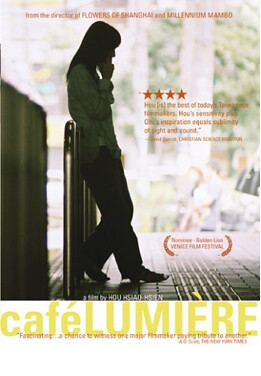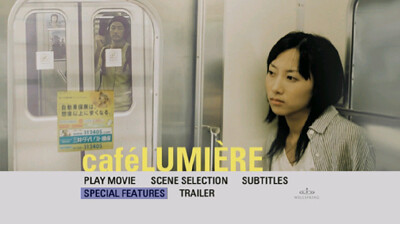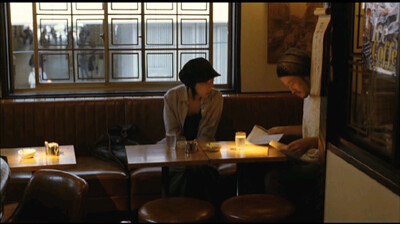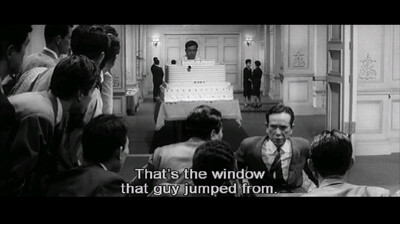THERE IS A LIGHT
Yasujiro Ozu stands alongside Akira Kurosawa as the two most influential original masters of Japanese Cinema. Had he lived, he would have turned one-hundred in 2003. To mark that occasion, Taiwanese director Hou Hsiao-hsien has made what may be the finest movie of his career, Café Lumiere
Released on DVD at the end of September, Café Lumiere has been a long time coming for stateside film fans. At the beginning of last year, Film Comment magazine named it as the best movie of 2004 that had yet to be released in North America. Having gained notice for his previous films, including the excellent Millennium Mambo

I am far from an Ozu expert, but my rudimentary understandings of his films is that he was mainly concerned with showcasing the lives of modern Japanese families. Sometimes, these could be very ordinary people, like the family in Early Summer (1951), and other times, he looked at what would happen when an out-of-the-ordinary life collided with the ordinary, such as when the traveling actors invade a small town in Floating Weeds (1959). While his stock and trade was understated melodrama, he wasn’t afraid of humor. Anyone who has seen his 1959 masterpiece Good Morning has never forgotten, for instance, the little boy who farts every time you push his forehead. His most primary theme was looking at how Japan was growing, examining how the older generation viewed the younger generation and usually siding with progress.
On the surface, there are some similarities between Ozu and Hsiao-hsien. Both seem to like characters who are searching for some kind of stability, and both employ an unhurried pacing to their storytelling. Hsiao-hsien, however, is not nearly as concerned with traditional narrative, choosing a free-form style that owes more to the French New Wave than traditional moviemaking. So, the question seemingly becomes how to attach that unmoored passion with Ozu’s simple sentimentality.
The result is breathtaking. Café Lumiere is stunningly haunting and quiet. It lacks both the melodrama and the laughter of Ozu’s classic oeuvre, but at the same time, Hsiao-hsien manages to create his own family of characters that are just as endearing as any portrayed by the master. (And the title is perfect for a movie where one filmmaker pays homage to another, as the Lumiere Brothers are often considered the founders of cinema, having put on the first public screening of a motion picture in 1895.)
There isn’t a lot of story to Café Lumiere. Yoko (Yo Hitoto) is a young Japanese girl living on her own. She divides her time between her Tokyo home and Taiwan, where she is researching a project on Jiang Wen-ye, a famous composer. She also occasionally goes to see her parents, including a trip for a ritual cleansing of the family gravestones. The small unit of three doesn’t speak much, and their initial conversations are just an exchange of basic pleasantries. Yoko, however, has a bombshell to drop: she’s pregnant and has no interest in marrying the father. The family reacts in its way, which is almost a non-reaction. As in Ozu, Yoko’s elders don’t know how to relate to her as a modern woman. They possibly see her as akin to the foolish girl in the strange dream Yoko had where a goblin came in and kidnapped a child under her watch. She is too young and incapable of such responsibilities. (Courtney Crumrin fans will likely appreciate the storybook Yoko looks through that details just such a misadventure, a European folk tale that Ted Naifeh referenced in one of his comics.)

These opening scenes are done in long takes, usually with the camera several feet away, sometimes just outside the room or far enough back into it that we can see the whole area and everyone in it. The action is commonplace, such as a family sitting at a table or Yoko on the train. Yoko spends the first scene with her back to the audience, talking on the phone, and we don’t really get a good look at her face until midway through the picture. The phone call is also one-sided. We never hear who is on the other end of any phone conversations, including with the Taiwanese man who is purported to be the father of her child. The effect is one of simultaneous distance and intimacy: we are at arm’s length, and yet we are seeing private lives play out. There is also a sense of mystery. Is Yoko just as distanced from everyone else, and if so, why? I started to wonder who exactly the father really was, because things are complicated by the presence of Hajime (Tadanobu Asano).
Hajime is a bookseller who helps Yoko track down CDs of Wen-Ye’s music, and they are trying to puzzle out where a long-gone jazz club he used to visit may have been. Hajime has his own private obsessions: he loves trains. He likes the order of them, he likes knowing their names, and he travels around with a tape recorder capturing their specific sounds. Their relationship seems entirely professional, except Yoko brings Hajime gifts and looks a little jealous when she is told some gossip about him having a bookstore groupie. The first real intimacy of the movie occurs when Hajime visits Yoko at her apartment and he shows her a computer program he has created that is an artistically visual map of the Japanese train system. He portrays himself at the center of it, as a fetal creature with a microphone growing in the womb of the railways. Here, Hsiao-hsien moves his camera in tight, almost on top of his actors. As they share their secret passions, they are finally connecting, finally opening up. It’s a technique he uses again when Yoko interviews Wen-Ye’s wife, and she shares cherished memories about the pictures in her photo album.
Café Lumiere is as subtle as it is moving. It doesn’t build to any great Hollywood climax, and yet one can’t help but be involved. It’s such an odd sensation when you watch a film that has such an obviously leisured pace, because so often it passes in a flash, as if the attention it requires of you as a viewer pulls you out of time. I was totally engrossed. As a tribute to Ozu, my feeling is that what Hsiao-hsien has done is abstracted the essential elements of his teacher’s work and grown something new out of them. Hsiao-hsien takes his own style and applies the lessons of the master to it, and I can’t imagine anything more flattering.

As a DVD, Café Lumiere is of exceptional quality. The lighting has a natural feel, and the colors are all warm. One scene between Yoko and Hajime in a Taiwanese café is particularly beautiful. An overhead ceiling lamp illuminates Hajime’s drink, creating an angelic spotlight on him. Additionally, the sound is crisp and captures the real noise of busy streets, creating the effect that there is movement all around you.
There are also plenty of extras, including short interviews with Hototo, Asano, and Hsiao-hsien, and “Metro Lumiere,” an hour-long French documentary about the filmmaker’s process, where Hsiao-hsien discusses his goals and his impressions of Ozu. Most interesting were his stories about the difference in filming in Japan as opposed to Taiwan, and how he and his crew often went after scenes in real life settings guerilla-style.
And before we switch gears, I’d be remiss if I didn’t note that Film Comment has once again put Hou Hsiao-hsien at the top of their list, citing Three Times as the best film of 2005 awaiting stateside distribution. Excellent! Something to look forward to! [EDIT: It has, of course, since been released, and I review it here.]
* * *
As for the other old master, Criterion has recently put out a new disc of one of Akira Kurosawa’s lesser known social dramas, The Bad Sleep Well. Hopefully this wonderful disc, with its gorgeous picture and sound quality, will increase the film’s reputation, because it certainly deserves it.

Made in 1960, The Bad Sleep Well was the first film from Kurosawa’s independent production company. Interwoven with themes and elements from Shakespeare’s Hamlet, it’s a story of corporate corruption and intrigue starring Kurosawa regulars like Toshiro Mifune and Takashi Shimura. A scandal is breaking out over a construction project where it appears that the government organization commissioning the work awarded a private company the contract despite their bid being several million yen higher than everyone else’s. Suicides within the company’s upper ranks have only added to the controversy. Just what are these people trying to hide?
I don’t want to get too much into the plot, because it takes a couple of twists and turns, and the way they suck the first-time viewer in is part of the experience. You aren’t even sure who your Hamlet stand-in is until about half an hour into the movie. What I can tell you is that this is one of the most expertly shot pictures in the Kurosawa canon. The opening sequence is rightly praised as one of Kurosawa’s most efficient and innovative. Set at a wedding, the ceremony is interrupted by quiet police officers, catty reporters (an excellent device to clear out a lot of exposition), and nervous executives using their toast time to try to save face. The real intrigue begins, however, when a mysterious cake is wheeled into the banquet hall. Sculpted to look like the company’s massive office building, a single red rose sticks out of the window the first casualty of greed hurled himself from. No one knows who sent the cake, no one knows why.

Kurosawa uses his patented pan focus to great effect in The Bad Sleep Well. Many of the complicated shots and some of Kurosawa’s off-kilter directing techniques are discussed at great length in the bonus documentary, part of the long Japanese series “It Is Wonderful to Create!” that Criterion has been including on a lot of their recent Kurosawa DVDs. Pan focus is when everything within the frame is visible with equal clarity, a technique also preferred by Orson Welles. Probably the most impressive and ironic uses of the style is in a scene where two characters sit in their car watching a funeral. The camera is placed in the back seat, and we look past our spies, through the windshield and across the road, and we can see everything going on at the funeral while a calypso soundtrack from within the car draws attention to what a sham the event is.
For 1960, The Bad Sleep Well was progressive and daring. It’s a cynical film that makes no bones about what kind of evil greed can drive men to and how high in our society this corruption goes. And it’s not hard to be just as cynical when we realize how biting this message still is forty-six years later.

No comments:
Post a Comment